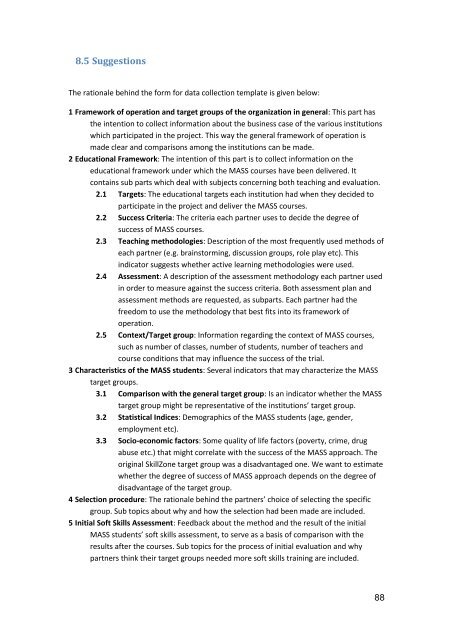Teaching and Assessing Soft Skills - MASS - Measuring and ...
Teaching and Assessing Soft Skills - MASS - Measuring and ...
Teaching and Assessing Soft Skills - MASS - Measuring and ...
Create successful ePaper yourself
Turn your PDF publications into a flip-book with our unique Google optimized e-Paper software.
8.5 Suggestions<br />
The rationale behind the form for data collection template is given below:<br />
1 Framework of operation <strong>and</strong> target groups of the organization in general: This part has<br />
the intention to collect information about the business case of the various institutions<br />
which participated in the project. This way the general framework of operation is<br />
made clear <strong>and</strong> comparisons among the institutions can be made.<br />
2 Educational Framework: The intention of this part is to collect information on the<br />
educational framework under which the <strong>MASS</strong> courses have been delivered. It<br />
contains sub parts which deal with subjects concerning both teaching <strong>and</strong> evaluation.<br />
2.1 Targets: The educational targets each institution had when they decided to<br />
participate in the project <strong>and</strong> deliver the <strong>MASS</strong> courses.<br />
2.2 Success Criteria: The criteria each partner uses to decide the degree of<br />
success of <strong>MASS</strong> courses.<br />
2.3 <strong>Teaching</strong> methodologies: Description of the most frequently used methods of<br />
each partner (e.g. brainstorming, discussion groups, role play etc). This<br />
indicator suggests whether active learning methodologies were used.<br />
2.4 Assessment: A description of the assessment methodology each partner used<br />
in order to measure against the success criteria. Both assessment plan <strong>and</strong><br />
assessment methods are requested, as subparts. Each partner had the<br />
freedom to use the methodology that best fits into its framework of<br />
operation.<br />
2.5 Context/Target group: Information regarding the context of <strong>MASS</strong> courses,<br />
such as number of classes, number of students, number of teachers <strong>and</strong><br />
course conditions that may influence the success of the trial.<br />
3 Characteristics of the <strong>MASS</strong> students: Several indicators that may characterize the <strong>MASS</strong><br />
target groups.<br />
3.1 Comparison with the general target group: Is an indicator whether the <strong>MASS</strong><br />
target group might be representative of the institutions’ target group.<br />
3.2 Statistical Indices: Demographics of the <strong>MASS</strong> students (age, gender,<br />
employment etc).<br />
3.3 Socio-economic factors: Some quality of life factors (poverty, crime, drug<br />
abuse etc.) that might correlate with the success of the <strong>MASS</strong> approach. The<br />
original SkillZone target group was a disadvantaged one. We want to estimate<br />
whether the degree of success of <strong>MASS</strong> approach depends on the degree of<br />
disadvantage of the target group.<br />
4 Selection procedure: The rationale behind the partners’ choice of selecting the specific<br />
group. Sub topics about why <strong>and</strong> how the selection had been made are included.<br />
5 Initial <strong>Soft</strong> <strong>Skills</strong> Assessment: Feedback about the method <strong>and</strong> the result of the initial<br />
<strong>MASS</strong> students’ soft skills assessment, to serve as a basis of comparison with the<br />
results after the courses. Sub topics for the process of initial evaluation <strong>and</strong> why<br />
partners think their target groups needed more soft skills training are included.<br />
88





